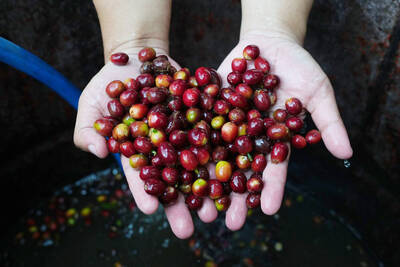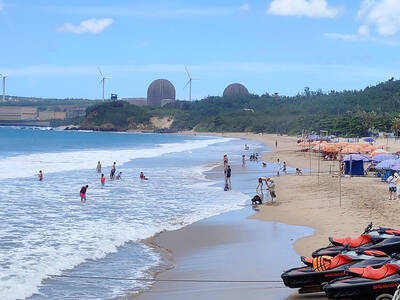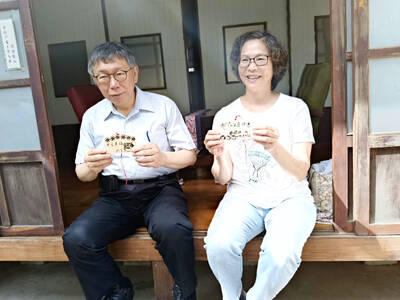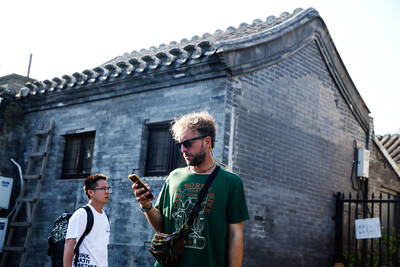Vincent van Gogh’s reputation precedes him. A failed preacher who later lived with a prostitute; a tormented artist who cut off part of his ear after arguing with Paul Gauguin and ended his life at the age of 37 with a self-inflicted gunshot wound; a painter of radiant pictures that today are among the most expensive of any artist in history.
Although the title, Van Gogh: The Flaming Soul, hints at the scandalous aspects of the post-impressionist’s life, the National Museum of History frames its exhibit in a different manner by showing his evolution as an artist — from his early drawings to the later oil paintings.
Over a year in the making, an insurance policy worth almost NT$30 billion, a renovated first and second floor, and 15 security guards ensured that this exhibit was going to receive a lot of press. The 77 drawings and 20 paintings on display from the Netherland’s Kroller-Muller Museum, plus Vase With Flowers and Thistles on loan from Japan’s POLA Art Foundation, make this the largest show of van Gogh’s work ever to be seen in Taiwan. It certainly presents a feast for the artistic appetite.
But all the hype surrounding the exhibit and the artist’s life are just an appetizer for what might turn out to be the year’s best show. The planners throw up his drawings first (located on the second floor) — as though museumgoers have to nourish themselves on a sumptuous repast of sketches and studies before they can get to the rich paintings (on the first floor) for dessert.
Arranged chronologically, The Flaming Soul begins when van Gogh, 27, set out to become an artist after failing as a preacher. He was under no illusions that he was coming to art relatively late and consequently spent much of the next five years devoting himself to sketching from photographs and prints by masters — such as realist peasant painter Jean-Francoise Millet — all the while studying books on composition.
The virtue of this exhibit is that it lets the sketches illustrate the process van Gogh underwent to become a great artist without distracting the viewer with commentary (the exhibition catalogue adequately provides this). What the dozens of studies of farmers and fishermen, women and weavers reveal is van Gogh’s aspiration to become a painter of peasant life.
The Potato Eaters (1885) can be seen as a culmination of these studies and was the first work he felt could establish his reputation. The oil painting shows five farmers sitting around a table inside a cramped room, their faces illuminated by a single lamp from above. The tones, like most of the pre-1885 paintings in this show, are a dark and somber mixture of chiaroscuro blacks, grays and blues reminiscent of Rembrandt’s gloomy interiors, with a touch here and there of beige.
Reviews from friends and acquaintances, however, were scathing. After receiving a print of the lithograph, van Gogh’s older artist friend Anthon van Rappard wrote, “[W]hy is everything observed and treated in a superficial manner? That coquettish little hand of the woman at the back, how unrealistic!” the letter screams.
“You dare invoke the names of Millet and [Emile] Breton? Come now! It seems to me that art is too esteemed to be treated so nonchalantly.”
After reading the letter (many of his letters can be found online at www.vangoghletters.org) van Gogh promptly returned it. But it seems that the ideas contained in van Rappard’s appraisal left a deep impression on the burgeoning artist, for in the summer of the same year he sent his brother a letter stating that he wasn’t seeking the exact representation of Millet, but expressiveness. Although he mentions the artist and art dealer Charles Serret in the letter, it could have been a response to van Rappard’s earlier rebuke.
“Tell Serret that I would be despairing if my figures were good, tell him I do not want them to be anatomically correct ... Tell him that my greatest desire is to reveal such inaccuracies, such deviations, revisions, alterations of reality, that they may be, well — lies if one pleases — but truer than the literal truth.”
It was only after arriving in Paris in 1886 and meeting up with and taking courses from impressionist artists that van Gogh was able to develop the visual language that expressed a truth “truer than the literal truth.”
The transition from draughtsman to painter was quick. Van Gogh imbibed the vibrant colors and experimental ideas of the impressionists as though quenching his thirst after finding his way out of a desert.
The dotted contrast of reds and greens on the wall and a mixture of yellow and purple on the floor of Interior of a Restaurant (1887), for example, show signs of Paul Signac’s pointillist influence on van Gogh and mark a departure from the gloomy interior of The Potato Eaters.
But van Gogh was also applying these newfound colors and textures to landscapes. View of Sainte-Maries-de-la-Mer (1888) — which bears a resemblance to Paul Cezanne’s vibrant landscapes — presents a farmer’s field rendered in dashes of lavender purple and cornflower blue with short brushstrokes of emerald green in the foreground rising up towards orangish-yellow buildings, the shadowed elements set off by turquoise, and reaching up to a subdued sky.
But it was only with the dancing brushstrokes (in this show at least) of Olive Grove and the built-up and undulating dabs of paint found in Country Road in Provence by Night that van Gogh attained a distinctive and imaginative style. Other oil paintings in this exhibit — Self Portrait received the ooohs and ahhhs that one might hear at a fireworks display — help to round out this must-see show.
More than anything else, however, by exhibiting early minor works alongside the later masterpieces, the museum highlights the importance of learning the fundamentals and persevering in the face of failure. Van Gogh might not have been the best draughtsman, but because he understood his own “flaming soul” he was able to create a unique body of work.

Climate change, political headwinds and diverging market dynamics around the world have pushed coffee prices to fresh records, jacking up the cost of your everyday brew or a barista’s signature macchiato. While the current hot streak may calm down in the coming months, experts and industry insiders expect volatility will remain the watchword, giving little visibility for producers — two-thirds of whom farm parcels of less than one hectare. METEORIC RISE The price of arabica beans listed in New York surged by 90 percent last year, smashing on Dec. 10 a record dating from 1977 — US$3.48 per pound. Robusta prices have

A dozen excited 10-year-olds are bouncing in their chairs. The small classroom’s walls are lined with racks of wetsuits and water equipment, and decorated with posters of turtles. But the students’ eyes are trained on their teacher, Tseng Ching-ming, describing the currents and sea conditions at nearby Banana Bay, where they’ll soon be going. “Today you have one mission: to take off your equipment and float in the water,” he says. Some of the kids grin, nervously. They don’t know it, but the students from Kenting-Eluan elementary school on Taiwan’s southernmost point, are rare among their peers and predecessors. Despite most of

The resignation of Taiwan People’s Party (TPP) co-founder Ko Wen-je (柯文哲) as party chair on Jan. 1 has led to an interesting battle between two leading party figures, Huang Kuo-chang (黃國昌) and Tsai Pi-ru (蔡壁如). For years the party has been a one-man show, but with Ko being held incommunicado while on trial for corruption, the new chair’s leadership could be make or break for the young party. Not only are the two very different in style, their backgrounds are very different. Tsai is a co-founder of the TPP and has been with Ko from the very beginning. Huang has

A few years ago, getting a visa to visit China was a “ball ache,” says Kate Murray. The Australian was going for a four-day trade show, but the visa required a formal invitation from the organizers and what felt like “a thousand forms.” “They wanted so many details about your life and personal life,” she tells the Guardian. “The paperwork was bonkers.” But were she to go back again now, Murray could just jump on the plane. Australians are among citizens of almost 40 countries for which China now waives visas for business, tourism or family visits for up to four weeks. It’s